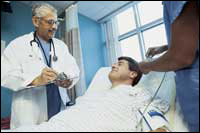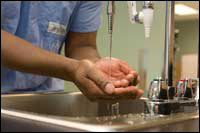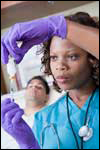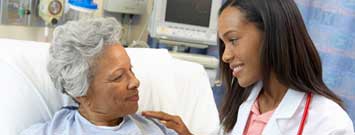Patient Safety: Ten Things You Can Do to Be a Safe Patient
Do you plan to go to the hospital today for an emergency? No one does!
 Imagine a scenario like the following:
Imagine a scenario like the following:
- Your mother starts having chest pain.
- Your son breaks his ankle during football practice.
- Your spouse is in a car accident.
You rush to the hospital.
Thankfully, you are told that your loved one is going to recover, but will spend some time in the hospital. However, extra time in the hospital can also put patients at risk for a healthcare-associated infection (HAI), such as a blood, surgical site, or urinary tract infection.
 Every day, patients get infections in healthcare facilities while they are being treated for something else. These infections can have devastating emotional, financial, and medical effects. Worst of all, they can be deadly.
Every day, patients get infections in healthcare facilities while they are being treated for something else. These infections can have devastating emotional, financial, and medical effects. Worst of all, they can be deadly.
Healthcare procedures can leave you vulnerable to germs that cause HAIs. These germs can be spread in healthcare settings from patient to patient on unclean hands of healthcare personnel or through the improper use or reuse equipment.
 These infections are not limited to hospitals. For example, in the past 10 years alone, there have been more than 30 outbreaks of hepatitis B and hepatitis C in non-hospital healthcare settings such as outpatient clinics, dialysis centers, and long-term care facilities.
These infections are not limited to hospitals. For example, in the past 10 years alone, there have been more than 30 outbreaks of hepatitis B and hepatitis C in non-hospital healthcare settings such as outpatient clinics, dialysis centers, and long-term care facilities.
Fortunately, the solution is clear. To prevent HAIs, everyone – you, your healthcare providers, and your visitors, should follow infection prevention procedures as described below.
What can you do as a patient or loved one of a patient?
Be informed. Be empowered. Be prepared.
Here are 10 ways to be a safe patient:
- Speak up.
Talk to your doctor about any worries you have about your safety and ask them what they are doing to protect you. - Keep hands clean.
If you do not see your providers clean their hands, please ask them to do so. Also remind your loved ones and visitors. Washing hands can prevent the spread of germs. - Ask if you still need a central line [PDF - 191KB] catheter or urinary [PDF - 226KB] catheter. Leaving a catheter in place too long increases the chances of getting an infection.
- Ask your healthcare provider, "will there be a new needle, new syringe, and a new vial for this procedure or injection?" Healthcare providers should never reuse a needle or syringe on more than one patient.
- Be careful with medications.
Avoid taking too much medicine by following package directions. Also, to avoid harmful drug interactions, tell your doctor about all the medicines you are taking. - Get Smart about antibiotics.
Help prevent antibiotic resistance by taking all your antibiotics as prescribed, and not sharing your antibiotics with other people. Remember that antibiotics don’t work against viruses like the ones that cause the common cold. - Prepare for surgery [PDF - 207KB].
There are things you can do to reduce your risk of getting a surgical site infection.Talk to your doctor to learn what you should do to prepare for surgery. Let your doctor know about other medical problems you have.  Watch out for C. diff [PDF - 179KB] (aka Clostridium difficile)
Watch out for C. diff [PDF - 179KB] (aka Clostridium difficile)
Tell your doctor if you have severe diarrhea, especially if you are also taking an antibiotic.- Know the signs and symptoms of infection.
Some skin infections, like MRSA, appear as redness, pain, or drainage at an IV catheter site or surgical incision site, and a fever. Tell your doctor if you have these symptoms. - Get your flu shot.
Protect yourself against the flu and other complications by getting vaccinated.
By following these 10 steps you can help make healthcare safer and help prevent healthcare-associated infections.
HAIs are not only a problem for individual healthcare facilities – they represent a public health issue that requires many people and organizations to work together in a comprehensive effort to attack these largely preventable infections. CDC is working with partners and states to implement infection prevention tools toward the elimination of healthcare-associated infections.
For more information visit Outpatient Settings
CDC acknowledges the work of several partners who are focused on safe healthcare:
- Agency for Healthcare Research and Quality
- American Hospital Association (AHA)
- Association for Professionals in Infection Control and Epidemiology (APIC)
- Centers for Medicare & Medicaid Services
- Consumer’s Union
- Council of State and Territorial Epidemiologists (CSTE)
- Department of Health and Human Services
- Food and Drug Administration
- Infectious Diseases Society of America (IDSA)
- The Joint Commission
- Safe Care Campaign
- Safe Injection Practices Coalition
- Society for Healthcare Epidemiology of America (SHEA)
Get email updates
To receive email updates about this page, enter your email address:
Contact Us:
- Centers for Disease Control and Prevention
1600 Clifton Rd
Atlanta, GA 30333 - 800-CDC-INFO
(800-232-4636)
TTY: (888) 232-6348 - New Hours of Operation
8am-8pm ET/Monday-Friday
Closed Holidays - cdcinfo@cdc.gov
 You go to the hospital to get well, right? Of course, but did you know that patients can get infections in the hospital while they are being treated for something else? Here are ten things you can do to be a safe patient.
You go to the hospital to get well, right? Of course, but did you know that patients can get infections in the hospital while they are being treated for something else? Here are ten things you can do to be a safe patient.

